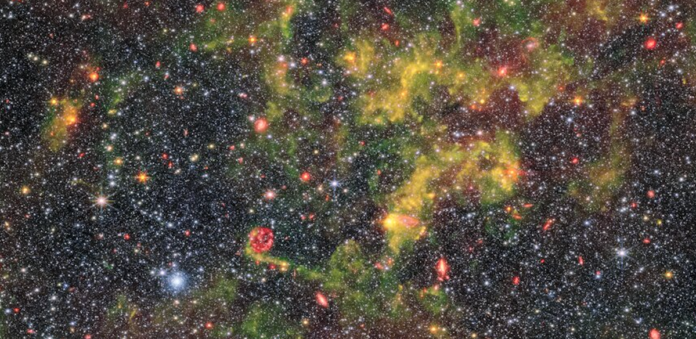An eerie-looking galaxy neighbouring the Milky Way has been revealed in never-before-seen detail by the James Webb Space Telescope . The Webb telescope’s new finding shows the eerie-looking and ‘irregular’ galaxy NGC 6822, also known as Bernard ‘s Galaxy, in unprecedented detail, shedding light on what a ‘very early’ universe may have looked like. The details in the image have revealed the stars of the galaxy, located about 1.5 light years away, in better clarity for further astronomical study. The galaxy is the nearest neighbour to the Milky Way, which is not one of its own companions and has low metallicity, meaning it contains low proportions of elements that are not hydrogen and helium, the European Space Agency (ESA) noted. Such elements other than hydrogen and helium are largely produced by stars over their entire lifetimes, so in the very early universe – before the first generation of stars were born, lived and died – everything had very low metallicity, scientists said. Astronomers said contemporary galaxies like NGC 6822, with low metallicity, can reveal how processes like the evolution of stars and the life cycle of interstellar dust occurred in the early universe . The galaxy was observed using the Near-InfraRed Camera (NIRCam) and Mid-InfraRed Instrument (MIRI) mounted on the Webb telescope. Both NIRCam and MIRI probe different parts of the electromagnetic spectrum, allowing the instruments to observe different components of the same galaxy. MIRI is especially sensitive to gas-rich regions while the NIRCam is suitable for observing its densely packed field of stars, the ESA noted. The NIRCam’s image has revealed the galaxy’s countless stars in unprecedented detail, with dust and gas that pervade the galaxy reduced to translucent red wisps, thus laying the stars bare for further analysis. The MIRI instrument’s image shows galactic dust in prominent detail, obscuring the stars and revealing blue light emitted by organic compounds called polycyclic aromatic hydrocarbons that play a critical role in the formation of stars and planets. Image shows the irregular galaxy NGC 6822 observed by the Near-InfraRed Camera (NIRCam) and Mid-InfraRed Instrument (MIRI) mounted on the NASA/ESA/CSA James Webb Space Telescope NGC 6822 was first discovered by EE Barnard, who presented his discovery in a very brief paper in 1884. The galaxy, however, was miscategorised as an ‘exceedingly faint nebula’ at the time. Then Edwin Hubble, the namesake of the Hubble space telescope, studied NGC 6822 in-depth and published a much more detailed paper on it in 1925. ‘NGC 6822, [was] the first object definitely assigned to a region outside the galactic system,’ the pioneering astronomer said. The new composite image combines the views of both of Webb’s instruments, revealing both green- and yellow-tinged swirls of gas and dust as well as bright red regions of star formation in the galaxy. Scientists hope further studies of NGC 6822 can shed more light on how the first galaxies in the universe began and what they looked like.
New Webb telescope image of galaxy reveals what early universe may have looked like
Sourceindependent.co.uk
RELATED ARTICLES


